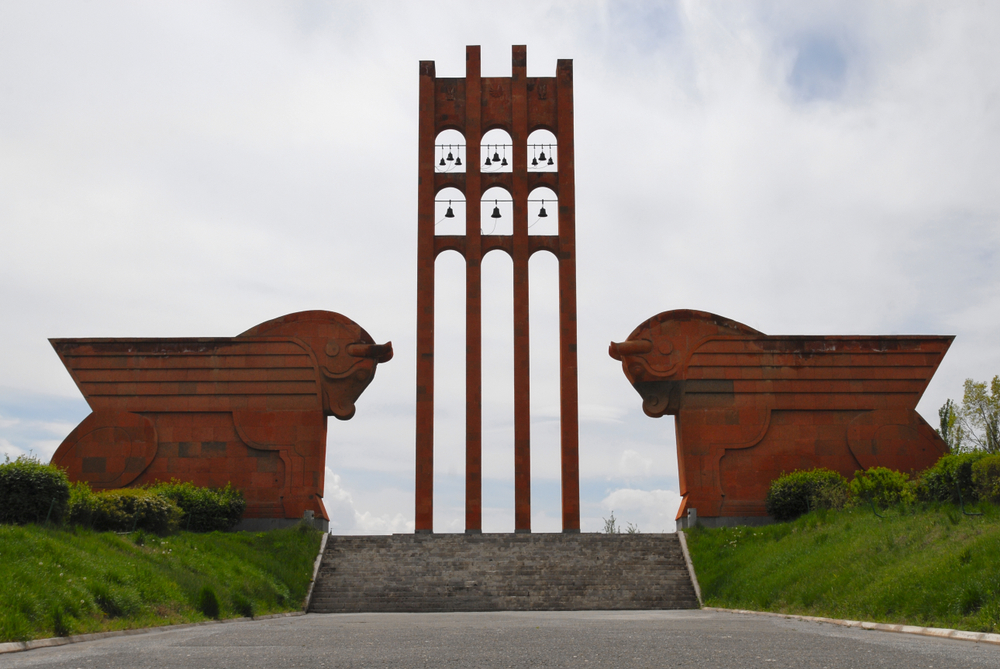
Sardarapat memorial complex, Armavir Region, Armenia © Kirill Skorobogatko/Shutterstock
Though protests against border delimitation and demarcation had started to wane in recent weeks, smaller acts of civil disobedience this week might well have rejuvenated the movement led by a renegade archbishop calling for the Prime Minister’s resignation
Demonstrations led by Archbishop Bagrat Galstanyan resumed Sunday after coming to a halt since 12 May, likely because of declining numbers, though random acts of civil disobedience in the capital continued. While the first demonstration attracted up to 30,000 people, two subsequent rallies managed only 11,000 and 9,000 respectively. Sunday’s gathering saw numbers rise to around 23,000. Even if still insufficient for political change in the country, it was enough to regain lost momentum.
The rally by the Tavush for the Motherland movement, now often referred to as the National Front, announced that the 53-year-old cleric would be nominated for the post of Prime Minister in the still unlikely event that two opposition parliamentary factions led by former presidents Robert Kocharyan and Serzh Sargsyan table a motion of impeachment against Pashinyan.
According to the Constitution, Galstanyan is ineligible to run as he holds dual Armenian and Canadian citizenship. While he says that he will renounce the latter, he has yet to do so and that would not change his situation either – by law, he would have to have held only Armenian citizenship for the four years prior. This has led to claims that Galstanyan and the opposition plan to overthrow the constitutional order by force.
Though claimed to be demonstrations against the delimitation and demarcation of one section of the border in the northeast of the country, critics argue that the actual goal of the movement has only been regime change. The night before, heavy rain flooded two regions in the northeast of the country, one of which was Galstanyan’s own diocese. Yet the Church Primate showed no interest in returning to support his congregation, even if Pashinyan had done so in order to assess the damage and supervise relief efforts. Galstanyan instead rallied and led a march to the Prime Minister’s residence in Yerevan in the unlikely hope of meeting with him.
Galstanyan called on the protesters to gather the following morning to continue their acts of disobedience in the hope of bringing the city to a standstill.
By Monday afternoon, 284 had been detained before a motorcade to the Sardarapat memorial complex was announced. Though Galstanyan did not explain why they would also stay overnight, it was clear to some – but apparently not the government – that they planned to prevent Pashinyan from entering the site the following next morning to commemorate the anniversary of the 1918 Armenian Republic. Senior officials gather annually to pay tribute in an official commemoration that also coincides with defeat of Ottoman forces at the same location. This year, Pashinyan could only attend after Galstanyan left later that afternoon.
What was unquestionably an embarrassing situation clearly irked Pashinyan, who appeared to be lambasting the church in his speech at the memorial. “[…] when we say the dream of the Armenian people, we often mean the dreams of groups that consider themselves elite, when we say the power of the people, we often mean the power of groups that consider themselves elite. And sometimes, even often, the people are assigned the role of a governed and dictated mass, the role of obedient subjects. […] Long live the government of the people”.
Further embarrassment occurred later, when the Armenian Catholicos was prevented from entering the memorial site too. Scenes shared on social media angered many when Karekin II and his entourage were temporarily obstructed by police. Until the two especially fell out following the 44-day war with Azerbaijan in 2020, the Catholicos had always been among the official delegation. According to Pashinyan, the Catholicos had not been invited and police were simply concerned that, like Galstanyan, he too was planning to disrupt events.
The Press Office of the Holy See of Etchmiadzin, however, says that the government was informed of Karekin II’s arrival in advance and accuses them of “provocation”.
Though it is clear that Galstanyan’s actions are both condoned and endorsed by the Catholicos, allegedly in order to benefit political forces close to the former regimes, the incident with Karekin II now threatens to transform into a direct confrontation between church and state. While Pashinyan might still be able to retain his grasp on power, it is possible that his position is weakening further, potentially making any attempts by Yerevan to normalise relations with Baku even more sensitive. Certainly, the protests are far from over and could continue for several more weeks.






